By Peter J. Nash
November 22, 2014
 |
When kids and collectors opened up their Donruss “Timeless Treasures” packs back in 2005, a select few were thrilled that they pulled “relic cards” celebrating the baseball career of Native American Olympic champion and Football Hall of Famer Jim Thorpe. The slick and graphically appealing cards were like miniature museums housing what the company claimed were ultra-rare and historic relics. When the consumers, both young and old, turned over their “lucky ticket” cards they read the Donruss statement endorsed by both MLB and the Baseball Hall of Fame which read:
“The enclosed piece of jersey was cut from an Authentic Jersey personally worn by Jim Thorpe in an official Major League Baseball game. The authentic Game-Worn Jersey was obtained and is guaranteed by Donruss Playoff L.P.”
The statement was definitive and unwavering with the additional visuals of the official logos of Major League Baseball, the Baseball Hall of Fame, the Cooperstown Collection, and the Giants featured prominently alongside the Donruss guarantee. Today these same cards are selling in the secondary market on eBAY and at Heritage Auction Galleries for prices ranging from $80 to $2,800 and are described as hobby treasures by media outlets like Beckett.com. Little did the kids and collectors realize, however, that every Thorpe card pulled from packs between 2005 and 2014 were outright frauds and actually housed old pieces of vintage flannel that the great Jim Thorpe never owned let alone ever wore in an actual Major League baseball game.
The flannel jersey that the card company had sliced and diced was a vintage New York Giants road jersey manufactured by A. G. Spalding Bros. sometime between 1921 and 1923— three to five years after Jim Thorpe played his last game for John “Mugsy” McGraw’s Giants–thus making it impossible for the Native-American legend to have ever worn the garment being promoted and sold by one of the most prominent players in the unregulated billion dollar sports memorabilia industry.
But how could this be? How could Panini America (formerly Donruss) and the powers that rule Major League Baseball be involved in such a scam targeting consumers? Were they all duped, or could it be that each of the entities involved failed to conduct their due diligence and should have known better? Or is it possible that they knew that there were serious problems with the bogus jersey fragments they were unloading on unsuspecting customers and collectors?
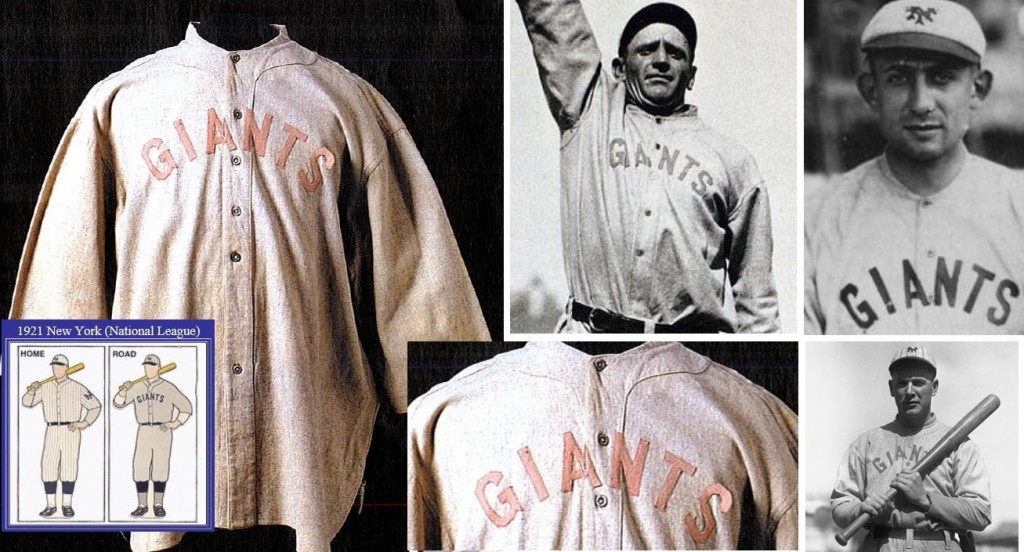
Jim Thorpe's alleged 1918 jersey sold for $46,000 in 1999 at Sotheby's. 1918 was one of the few years in which the team included a "G-I-A-N-T-S" logo across the chest. Photos from the early 1920s show Giant players Casey Stengel, Art Nehf and "Irish" Meusel wearing the exact same style with a distinctive placement of the letter "A" which separated into two parts when unbuttoned. These examples match the jersey sold by Halper and illustrations on the uniform database of the Baseball Hall of Fame (inset) which shows a matching 1921 jersey.
To understand the entire scope of the Jim Thorpe relic-card fraud we have go back about fifteen years to the sales floor of Sotheby’s in New York City when the original uncut Thorpe jersey was sold on the auction block as part of the once prominent baseball collection of the late New York Yankees minority partner Barry Halper.
Halper’s alleged 1918 Thorpe jersey was advertised as an authentic New York Giants road jersey manufactured by Spalding with the name “Thorpe” chain stitched in black thread in the back of the collar next to the Spalding label. Without any photo documentation of Thorpe wearing this exact same jersey in a game, the chain-stitched name was the only evidence suggesting that the jersey was made for Thorpe’s use in Major League games. Sotheby’s lead cosultant, Rob Lifson, of Robert Edward Auctions, described the jersey in his catalog description as an “important relic” and said that it ”may be the only surviving Jim Thorpe jersey from his professional baseball career.”
Lifson also hired Richard Russek and Andy Imperato of Grey Flannel to authenticate the Thorpe jersey (and every other garment in the Sotheby’s sale) and in the auction catalog Lifson stated, “Grey Flannel Collectibles Inc. is honored to have had the opportunity to evaluate and authenticate this wonderful collection of uniforms and jerseys belonging to Barry Halper.” Months before the auction, the hobby newsletter the Sweet Spot published a story about Grey Flannel’s work with the collection and indicated “It is believed that the origination of some of the jerseys will be questionable.” Imperato told the Sweet Spot that many of the older jerseys were missing tags and that it would be “uncertain who wore them.” Imperato noted that “jerseys of certain eras should have names stitched in, but do not” while “others have undergone number changes.” He added, “There will be stuff where we just don’t know and we’ll have to do the best we can.” When Grey Flannel authenticated the Thorpe jersey it appears that the chain stitched name in the collar was the only link to alleged game use by the Olympic champion.
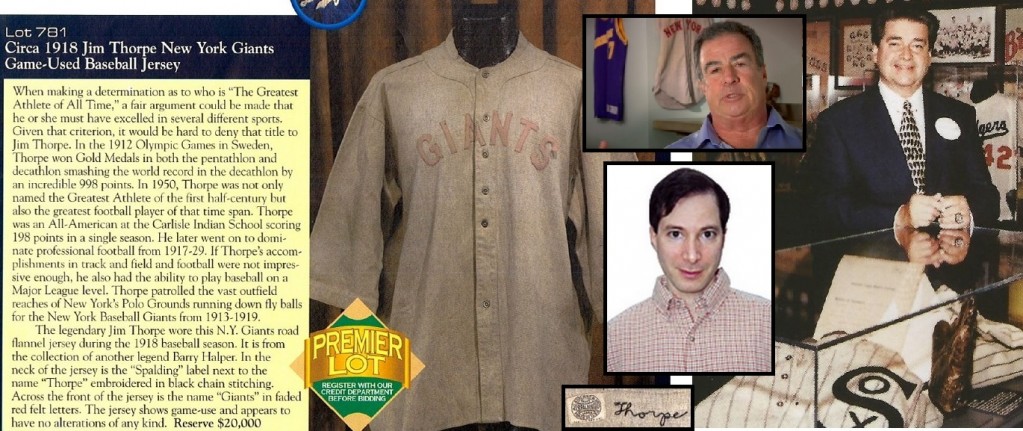
The Thorpe jersey sold again in 2004 for almost $60,000 at Grey Flannel (left). The jersey had been legitimized through authentications and manufactured provenance provided by Richard Russek (top), Rob Lifson (bottom) and original seller Barry Halper (pictured with the bogus "Shoeless" Joe Jackson jersey he sold the HOF.)
With the blessing of Lifson and Grey Flannel and its Halper Collection provenance, the Thorpe jersey sold for $46,000 to Greg Manning & Co. a sports collectibles company headed by Greg Manning who was identified in post-sale reports as one of the biggest buyers in the Halper sale. Shortly after his company’s purchase of the Thorpe jersey, Manning ran a full page ad in Sports Collectors Digest showing off his new acquisitions including Thorpe’s 1918 Giants jersey which he described as “the only one in existence.” Manning’s company, however, soon after liquidated many of his Halper acquisitions including the Thorpe jersey which ended up in a Grey Flannel auction in 2004 where it sold for $59,542 and was again authenticated by Russek and Imperato who said in their lot description, “The legendary Jim Thorpe wore this NY Giants road flannel jersey during the 1918 baseball season. It is from the collection of another legend, Barry Halper.” Back in 1998 (before the Sotheby’s sale) Halper had also sold some of the gems in his collection for close to $8 million to MLB and the Baseball Hall of Fame and in 1999 the Barry Halper Gallery was created in the Cooperstown museum to honor Halper’s career as a collector. But the authenticity of many of Halper’s uniforms had already been challenged by auctioneer Josh Evans of Lelands who informed Halper, Lifson, Grey Flannel and Baseball Hall of Fame board member Bill Gladstone that he believed that many of Halper’s jerseys from the Dead-Ball era and earlier were forgeries.
After the hammer dropped at the Grey Flannel auction in 2004, the new owner of the Halper-sourced Thorpe jersey was the Donruss Trading Card Company and they had plans to cut the jersey up into pieces and create Jim Thorpe-themed “relic cards” to serve as an incentive for collectors to buy more product in their quest to collect cards incorporating authentic game-used memorabilia. In 2005 Donruss began producing the first of over two thousand relic cards which housed actual swatches of Halper’s old jersey and in 2012 and 2013 the same company, which had been purchased by Panini, was even using the buttons from the Thorpe shirt to create new “button cards” with manufactured rarity. The 2012 issue was called “Panini National Treasures” and was licensed and endorsed by the Baseball Hall of Fame.
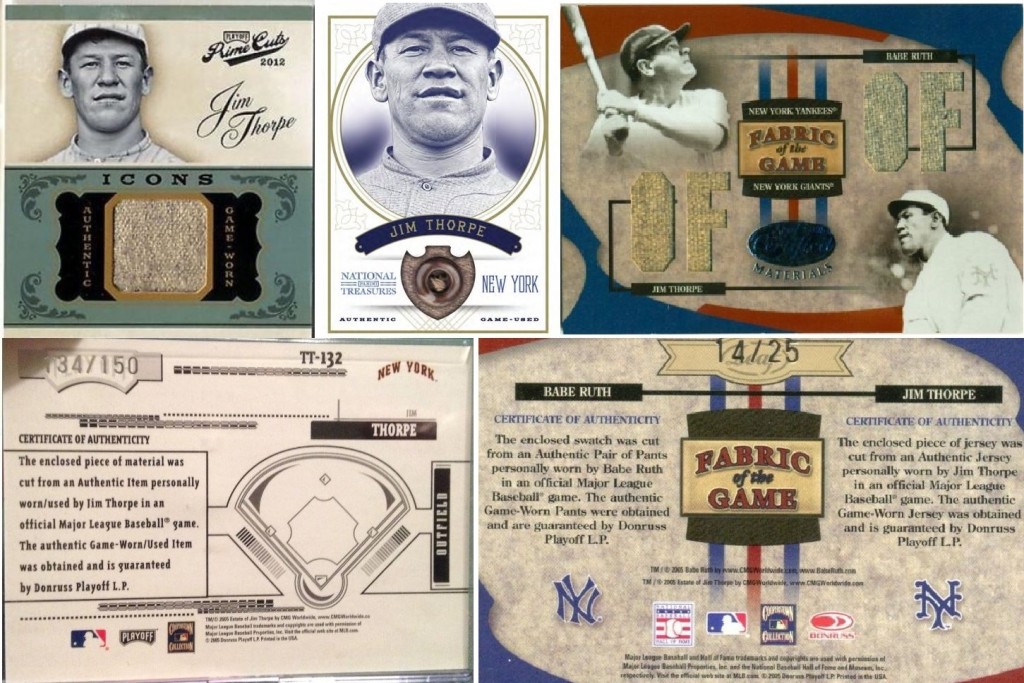
Donruss and Panini produced Thorpe relic cards with manufactured rarity in select "limited edition" runs of 25-50-150 and 250 Thorpe "relic cards" which were endorsed by MLB and the Baseball Hall of Fame.
But by 2012, it was public knowledge that a large portion of Barry Halper’s vintage jerseys sold to the Baseball Hall of Fame and at Sotheby’s were counterfeits and fabricated frauds. The alleged rare jersey he claimed was once worn by “Shoeless” Joe Jackson was exposed as a fake in a report published by this writer for Hauls of Shame and subsequent testing conducted by the Hall of Fame proved that the jersey was created with materials manufactured well after Jackson’s playing career. Other jerseys attributed to Mickey Mantle’s rookie year and to Negro Leaguer Buck Leonard were exposed as frauds and dozens of jerseys sold at Sotheby’s were also proven to be counterfeits by this writer and uniform expert Dave Grob, of MEARS. One particular jersey attributed to 19th century star Wilbert Robinson sold for $32,000 in the 1999 Halper sale and later sold for only $1,000 at Legendary Auctions after it was also exposed as a fake. Another 1907 jersey attributed to Hall of Famer Jimmy Collins was rejected by Grey Flannel nearly a decade after the company authenticated it for the Halper sale. In a letter to the collector who paid over $30,000 for the Grey Flannel-certified Collins jersey, Russek said, “As you are well aware, those 19th century (Halper) jerseys are full of controversy and we would be uncomfortable running it.”
With stories published in the mainstream media in the New York Post and Deadspin, the Halper frauds were well documented and much more than just controversial. That being said, it appears that Panini, MLB and the Baseball Hall of Fame either failed to conduct proper due diligence related to Halper’s Jim Thorpe jersey or, perhaps, decided to conceal the reality that the Thorpe jersey was a fraud just like so many other Halper-sourced garments from the Sotheby’s sale. Earlier this month collector Michael Jacobs from Pennsylvania filed suit against the Barry Halper estate and Grey Flannel Auctions claiming that an alleged 1951 Willie Mays rookie jersey he purchased for close to $70,000 was also exposed as a fake by uniform expert Dave Grob. The collector had arranged a sale of the jersey for $675,000 to Lelands Auctions but the transaction was nixed when Grob’s findings were revealed. To date, none of the major card companies, MLB or the Baseball Hall of Fame have ever retained the services of Grob who has been widely known as the leading expert for uniforms and jerseys for the past fifteen years.

The HOF uniform database, based on the work of Mark Okkonen (right), shows that the 1918 Giant uniforms differ distinctly from the 1921 and 1922 uniforms worn by the team. The alleged Jim Thorpe jersey dates it to the 1920s making it impossible to have been worn by Thorpe.
What is truly stunning about the Thorpe jersey used by Panini is that it could have easily been identified as a fraud by simply visiting the Baseball Hall of Fame’s website to view its “Dressed to the Nines” uniform data base. That online data base, created from the published work of uniform historian and SABR member Marc Okkonen, shows that the alleged Thorpe jersey features letter placement of the letters “G-I-A-N-T-S” that was only used by the ball club during the early 1920s. Okkonen’s illustrations of the Giant uniforms in 1921 and 1922, in particular, show a distinctly different placement of the letter “N” in opposition to the 1918 version and the same as the Halper jersey.
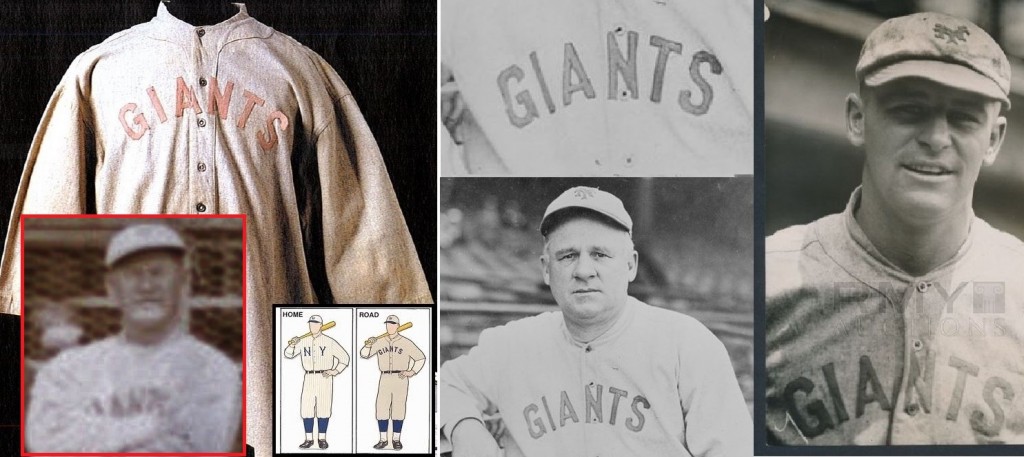
Vintage images of the 1918 NY Giants, including a blurry image of Jim Thorpe (inset), show that the 1918 team jerseys incorporated the letter placement shown in the Okkenen database. The photos of John McGraw and Ross Youngs (above) prove that the Halper Thorpe jersey was not genuine.
Not relying simply on the illustrations created by Okkonen, we researched photographs of the Giant players in 1918 and those images supported Okkonen’s illustrations and verified that 1918 Giant road uniforms incorporated the “N” in “GIANTS” directly in the center of the jersey on the middle fabric strip that the buttons are sewn upon. Unlike the Giant uniforms from the 1920s (and the Halper jersey) the 1918 uniforms featured an “A” placed to the left of the middle strip of the shirt and in one piece that does not separate into two when the shirt is unbuttoned.
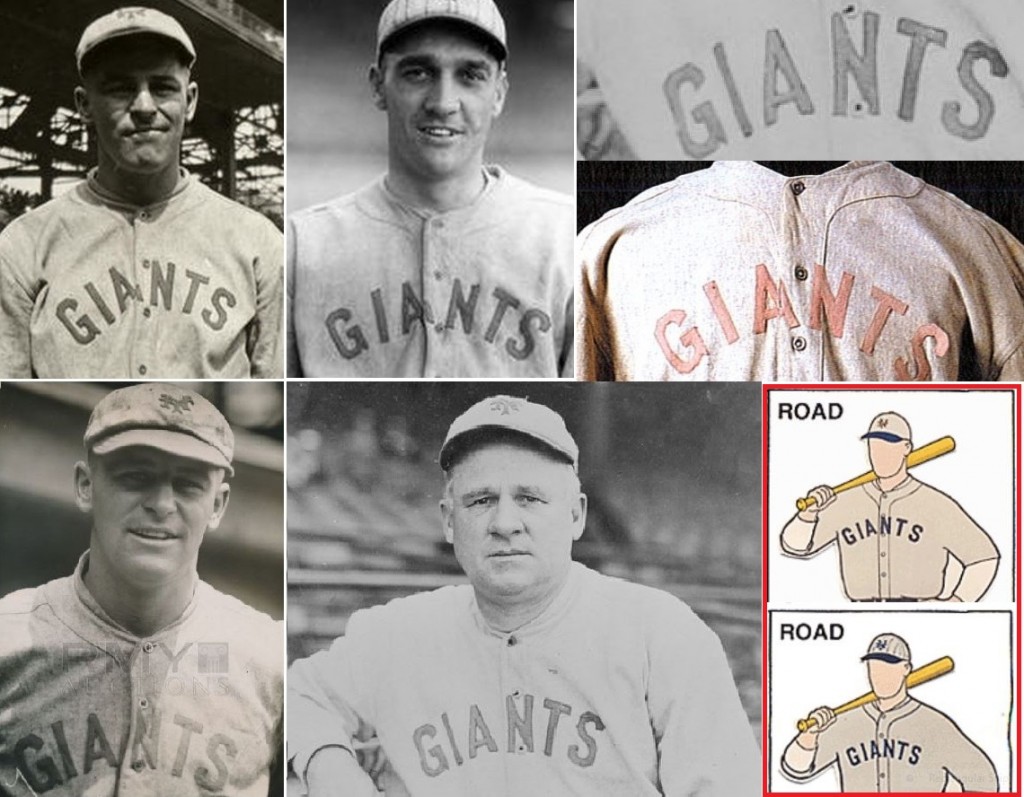
Photographs show the Giants wearing different road jerseys in 1918 including Ross Youngs and John McGraw (bottom row). In 1921 and 1922 the jerseys worn by Youngs and George Kelly (top row) were distinctly different. The alleged Thorpe jersey cut to create the Donruss/Panini relic cards was manufactured several years after Thorpe left the Giants. Mark Okkonen's illustrations also show it is impossible for the Halper jersey to be genuine.
The evidence illustrating that the Halper jersey was never worn by Jim Thorpe is quite definitive. It is impossible for Thorpe to have played in a MLB game wearing a uniform that was manufactured two to three years after he was no longer playing with the team. In addition, the details regarding the dating of the uniform suggest that the “Thorpe” name which was chain-stitched into the shirt’s collar next to the Spalding label was placed there in the past few decades and, like the name stitched into Halper’s bogus “Shoeless” Joe Jackson jersey, is an intentional forgery. In 2005, Donruss created a special card which incorporated the section of the Thorpe jersey featuring the swatch of flannel with the entire chain-stitched name. The card was featured in Donruss advertisements and published in hobby magazines and the Beckett Price Guide. Despite the fact that the company expended considerable capital to promote these cards as historic “relics,” every single Thorpe card created by Donruss and Panini since 2005 has been a fraud featuring a swatch from a jersey that Thorpe never wore.

The bogus chain-stitched "Thorpe" name included in the Donruss card is similar to the Joe Jackson forgery sold to the Hall of Fame (center) and two alleged Joe DiMaggio uniforms (right) sold by REA as replicas.
By the time Donruss created and sold the first Thorpe relic cards in 2005, it was already well known among hobby insiders that there were serious authenticity issues with the majority of Halper’s early vintage flannel jerseys. In 2007, Halper’s lead consultant at Sotheby’s, Rob Lifson, was also fully aware that several important jerseys Halper had represented as genuine and had sold to MLB and the Hall of Fame for hundreds of thousands of dollars were forgeries. Despite that knowledge, however, Lifson sold off several of those jerseys after Halper’s death in 2007 and sources say he intentionally misrepresented them as “replica jerseys“. Mickey Mantle’s 1951 rookie jersey and his Kansas City minor league jersey, which Halper sold to MLB and the Hall of Fame, were decribed by Lifson in his REA sale as: ”Garments (that) were created using vintage flannel jerseys from the period as a foundation, thus giving them the true look and feel of 1950s style jerseys. The lettering, numerals, and stitching in the collar too were carefully applied to mimic those used on actual Yankee jerseys.”
In another lot sold in 2007, two fraudulent Joe DiMaggio jerseys were described by REA and Lifson as:
“These two unique replica jersey were created with vintage materials in order to more accurately commemorate Joe DiMaggio’s early career. Joe DiMaggio later signed (7/8″) each jersey in the collar as a favor for Barry Halper. Neither of these jerseys would ever fool an expert, anymore than a modern-day replica would, nor are they intended to, but at a glance both look very much like authentic Joe DiMaggio 1930s style Yankees road jerseys…The lettering, numerals, and stitching in the collar too were carefully applied to mimic those used on actual Yankee jerseys.”
REA was correct that the jerseys were meant to mimic the originals but as forgeries, not replicas. While Lifson claims that these jerseys could never fool an expert, the facts show that the DiMaggio “replica” was purchased by MLB and the Hall of Fame from Halper in 1998 and it had even fooled DiMaggio.
Even more remarkable is the fact that since the day the bogus Thorpe jersey hit the market at Sotheby’s in 1999, all authenticators had to do was purchase a copy of Marc Okkonen’s MLB uniform compendium, Baseball Uniforms of The 20th Century, and compare the Halper example to the illustration the author depicted as the style the 1918 Giants wore. Just by looking at that page in Okkonen’s book would have given authenticators, Sotheby’s, Donruss, MLB and the Baseball Hall of Fame sufficient pause to question the authenticity of the jersey and the attribution of Thorpe’s game-use. In fact, the Hall of Fame endorsed the Donruss product back in 2005 when Okkonen’s analysis was illustrated on the Hall’s own website in the online exhibit known as “Dressed To The Nines.”

The fraudulent chain stitched Thorpe name from the Halper jersey was featured in its own relic card and advertised in Donruss ads in 2005. In 2011 Panini CEO signed a partnership deal with the Baseball Hall of Fame headed by Chairman Jane Forbes Clark and President Jeff Idelson.
Not only should the Hall have referred to their own online resource that showed the jersey was problematic, but by the time of the 2012 Panini release they should have seriously questioned and investigated any Halper-sourced garment after other fakes had already been exposed in their own collection that they had displayed as genuine to hundreds of thousands of visitors and fans. Knowing that the jersey had a Halper provenance should have raised red flags for the Hall regarding the legitimacy of the jersey and its licensing agreement with Panini. Hall of Fame President Jeff Idelson did not respond to our inquiry asking what due diligence his staff conducted in relation to their agreement with Panini/Donruss.
We also contacted MLB’s Commissioner’s office and asked Matt Bourne, MLB’s VP of Business Media Relations, what due diligence MLB or the MLBPA conducted in relation to Panini producing relic cards with alleged “game-used” materials and bearing the MLB logo? We also asked him whether MLB conducted additional due diligence on materials sourced to ex-MLB owner Barry Halper knowing that Halper had defrauded MLB in 1998 when he sold millions in bogus artifacts to the Hall of Fame? Bourne and MLB did not respond to our inquiry.
In reviewing the Beckett.com database it appears that, at a minimum, Donruss and Panini have sold over 2,000 Thorpe relic cards created from the fraudulent Halper jersey. In the October issue of Beckett Sports Card Monthly editor Chris Olds states that the Beckett database also shows that “there are 1,001,558 different memorabilia cards of the game-used (or event used) variety out there for collectors to chase.” According to Olds, that number has increased by 263,163 in the past three years.” While Olds notes the growth of the relic card population in such a short time period, he makes no mention of the recent controversies linked to the FBI investigation that nabbed several dealers who were selling a significant volume of fake materials to the card companies for game used relic cards.

Barry Halper sold millions in fakes including a bogus Joe Jackson jersey to the HOF, but Beckett Media's Chris Olds (inset right) has defended him along with REA's Rob Lifson and blogger Murray Chass (inset left). Olds featured a fake Thorpe relic card in his October Beckett column (center) which says there are over 1 million relic cards in the hobby.
In 2012, Olds published a post at Beckett.com commenting that a small number of fraudulent modern items shouldn’t taint the larger population of game-used cards but his commentary never addressed the probability that a good majority of the vintage materials the card companies were purchasing had even greater issues regarding authenticity. That being said, Olds’ recent October, 2014, column illustrates a bogus Thorpe-themed relic card produced by Panini/Donruss. In his column, Olds has publicly defended Halper’s well-established frauds along with REA’s Rob Lifson, blogger Murray Chass and Halper’s son, Jason, and has claimed that this writer’s reporting of the late Yankee partner’s frauds is just “mud-slinging“. Olds, who sources say lacks credibility because of his close ties to the card companies, did not respond to our requests for comment.
Our on-going investigation into relic and game-used card fraud extends far beyond the bogus Thorpe uniform swatches and a perfect example of how widespread the problem is the discovery last week by collectors at the Blowout Cards Forum that Panini produced fraudulent 2014 NFL cards that were advertised as containing “game-used” materials. The collectors pointed to unquestionable proof that the company used generic “event” products instead of actual “game used” materials actually worn by players like Russell Wilson and Colin Kaepernick. In response to the exposure of the problem Panini published a press release on its website authored by CEO Mark Warsop stating that what had occurred was just a “regrettable mistake” and that the “event worn” materials were used in error. Said Warsop, “There is nothing we take more seriously here at Panini America than the ironclad authenticity of our products — and the memorabilia and autographs we use to make them.” The CEO of the NFL licensee added, ”There was no intent to deceive or to portray those pieces of memorabilia as anything other than what they are: Event-worn by those players. The error in this case occurred in the labeling of those cards, not in producing them. We pride ourselves in being true to our consumers and in standing by every product we make. We absolutely will do that in this regard.”
We called Panini and informed the CEO and its product manager, Tracy Hackler, of the issues regarding the company’s Thorpe-related products and we also wanted to ask for the company to specifically identify which jerseys and bats it acquired to cut up and create its relic cards from 2005-2014 of Babe Ruth, Lou Gehrig, Joe DiMaggio, “Shoeless” Joe Jackson and Stan Musial. Neither Warsop or Hackler have responded to our inquiry.
When the dealers convicted of selling Panini bogus “game-used” materials were sentenced in 2012, their attorneys claimed that Panini was complicit in the crimes and that they invited fraud with their sub standard acquisition methods for obtaining “game-used” materials at a discount. Panini, in turn, filed a “Victims Impact Statement” for the “Jersey-Gate” cases claiming damages and requesting restitution in the millions from the presiding judge. The court, however, denied their request and decided not to award the company any restitution whatsoever, not even a penny.